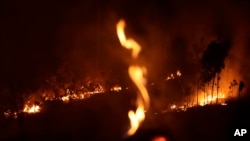As large parts of the Amazon burn, weather experts are warning that rainfall is unlikely to put out the fires in the coming weeks.
The Amazon is the world’s largest rainforest.
Brazil’s National Space Research Institute studies deforestation -- the clearing or removal of trees from the area. It reports that the number of fires has risen by 85 percent to more than 77,000 in the past year. That is the most since the research center began keeping records in 2013.
The fires are not limited to Brazil. At least 10,000 square kilometers of land are burning in Bolivia, near its border with Brazil and Paraguay.
Brazil’s government has deployed troops and military airplanes as part of firefighting efforts. But they will only be able to put out smaller fires and help to prevent new fires, experts say. The larger fires can only be put out by heavy rain.
The rainy season in the Amazon usually begins in late September. It takes weeks to build to widespread, heavy rains throughout the area.
The little rain that will fall in the next 15 days will be in areas that need it the least, says Maria Silva Dias. She is a professor of atmospheric sciences at the University of Sao Paulo.
Little rainfall is expected in the parts of the Amazon that are experiencing the worst fires, she added. “The whole area needs it to rain more…and this will only happen further down the line, around October,” she said.
Heavy rain has to fall in a short enough period to put out a fire. If there is little rainfall, the water changes from a liquid to a gas and rises as moisture in the air, Dias explained. She estimated it would take at least 20 millimeters of rain within 1-2 hours to put out a forest fire, with more required for the larger ones.
“In some areas, it could reduce the fires, not in general,” notes Matias Sales. He is a weather expert with the weather information company Climatempo.
Dias said that she hoped Brazil’s military would help to prevent new fires, but putting out existing fires is difficult work.
Firefighting work
In the Amazon, Brazilian firefighters wear rubber backpacks equipped with water hoses as a truck carries them toward heavy smoke. A guide flying in a military helicopter directs them to a fast-spreading fire.
A landowner opens an entrance to the property, and the firefighters set to work. They put out a fire they believe was set by farmers to prepare land for crops. When their water supply runs out, they create a fire break. This involves removing small plants with machetes and chainsaws to clear a space where the fire will not burn.
An Associated Press, AP, team watched the firefighters near the Jacunda national forest in the Amazonian state of Rondonia.
The AP team drove for hours on roads outside the state capital of Porto Velho without seeing any major fires. It appeared that the fires had burned themselves out. Many fires had been set on already deforested areas to clear the land for farming.
Brazilian President Jair Bolsonaro has said he might visit the Amazon this week to see the firefighting efforts. He also said that he would send 44,000 troops to fight the fires. However, on Monday, there were only a few soldiers on the roads in the area.
On a recent morning at sunrise, the sun was hidden behind thick smoke that fell like fog. Trucks carrying freshly cut trees sped along a road that cut through lands where ash hid and freshly burned trees lay on the ground.
Some Brazilians seemed to understand both sides of the argument: The fires are destroying their environment; but many people need to use the Amazon’s rich natural resources to earn money.
“The government has to help small farmers more…and take care of the large reserves, where people do most of the illegal things,” said Willian Sabara Dos Santos, who heads a farm. Behind him, a Brazilian flag waved in the wind.
In a nearby village, Darcy Rodrigo De Souza walked into a store where people drank coffee and ate Pao de Queijo, traditional Brazilian cheese bread.
“We have many problems with the fires. But we also depend on the wood for our economy. If it wasn’t for that, there would be nothing,” said De Souza.
“It’s true that the Amazon has to be protected, but this president is going to protect it. The Americans want us to protect Brazil. But why don’t they protect their (land)?” he asked.
Environmentalists say the Amazon’s forests are an important defense against climate change. About 60 percent of the Amazon is in Brazil. The rest can found in parts of Bolivia, Paraguay, Colombia, Ecuador, French Guiana, Guyana, Peru, Suriname and Venezuela.
I’m Susan Shand.
The Associated Press and the Reuters News Agency reported this story. Susan Shand adapted it for VOA Learning English. George Grow was the editor.
Write to us in the Comments Section or on our Facebook page.
_____________________________________________________________
Words in This Story
moisture – n. wetness; a gaseous form of water or other liquid
backpack – n. a piece of equipment carried on a person’s back
hose – n. a tube or pipe used to carry water, often for watering plants and in firefighting
machete – n. a large, heavy knife that is used for cutting plants and as a weapon
chainsaw – n. a tool that cuts wood that is driven by a motor and made up of many connected sharp metal teeth
reserve – n. a large amount of land that cannot be built on or changed in any way






